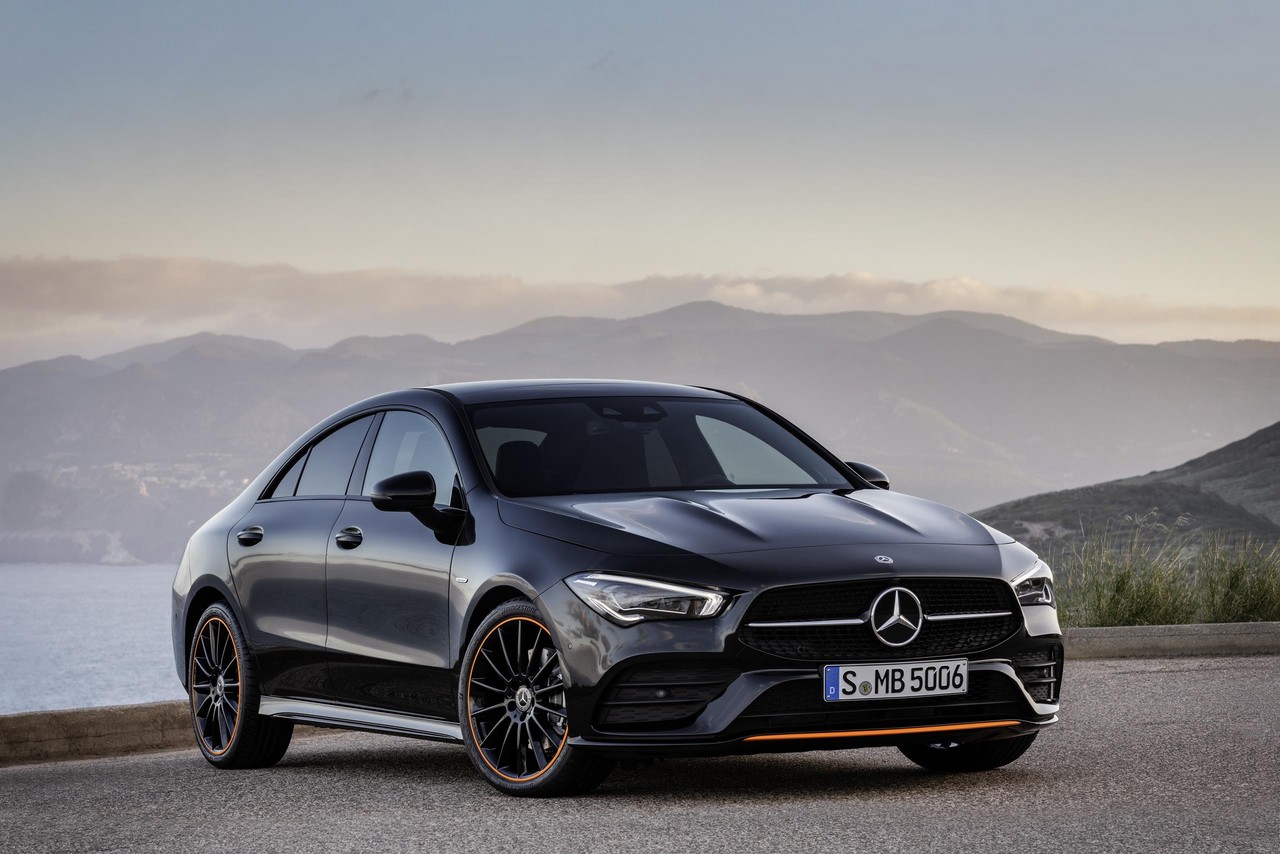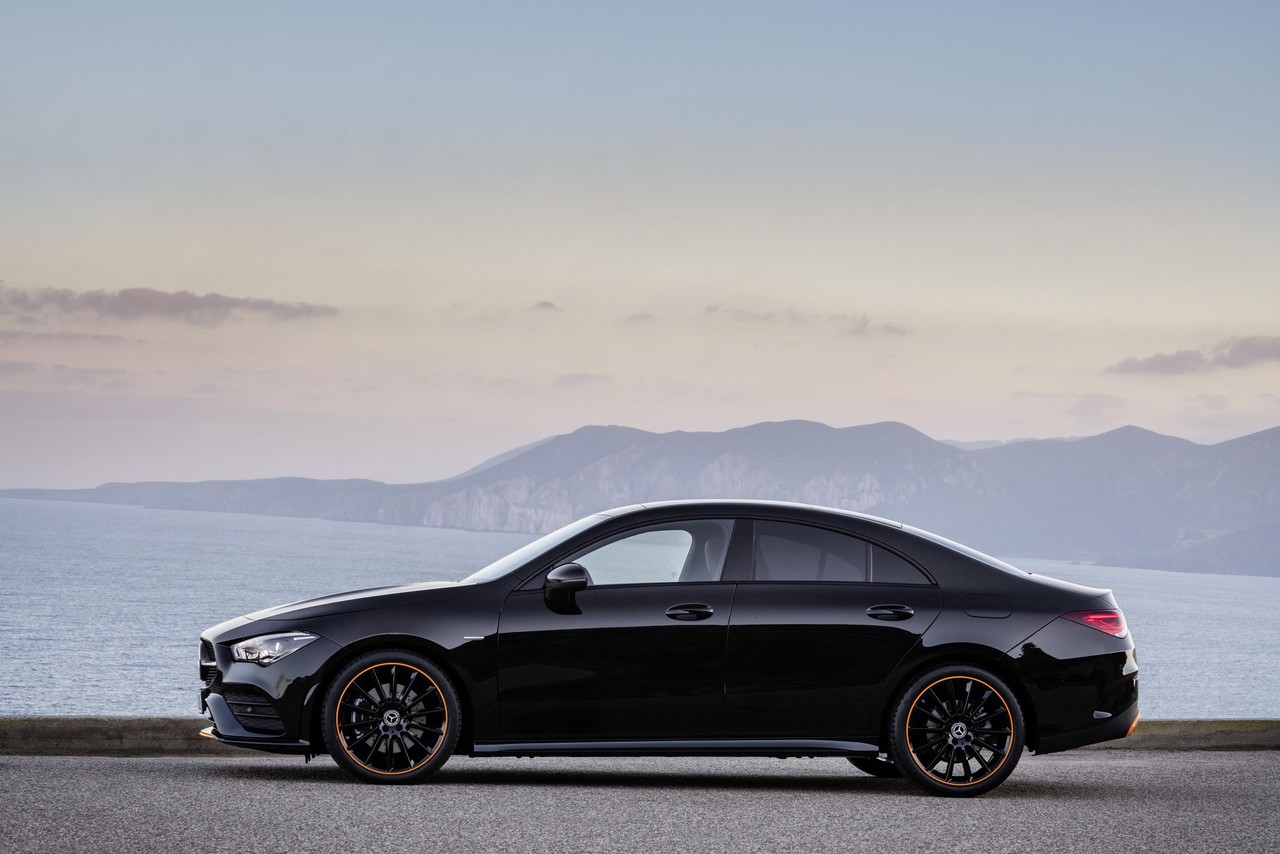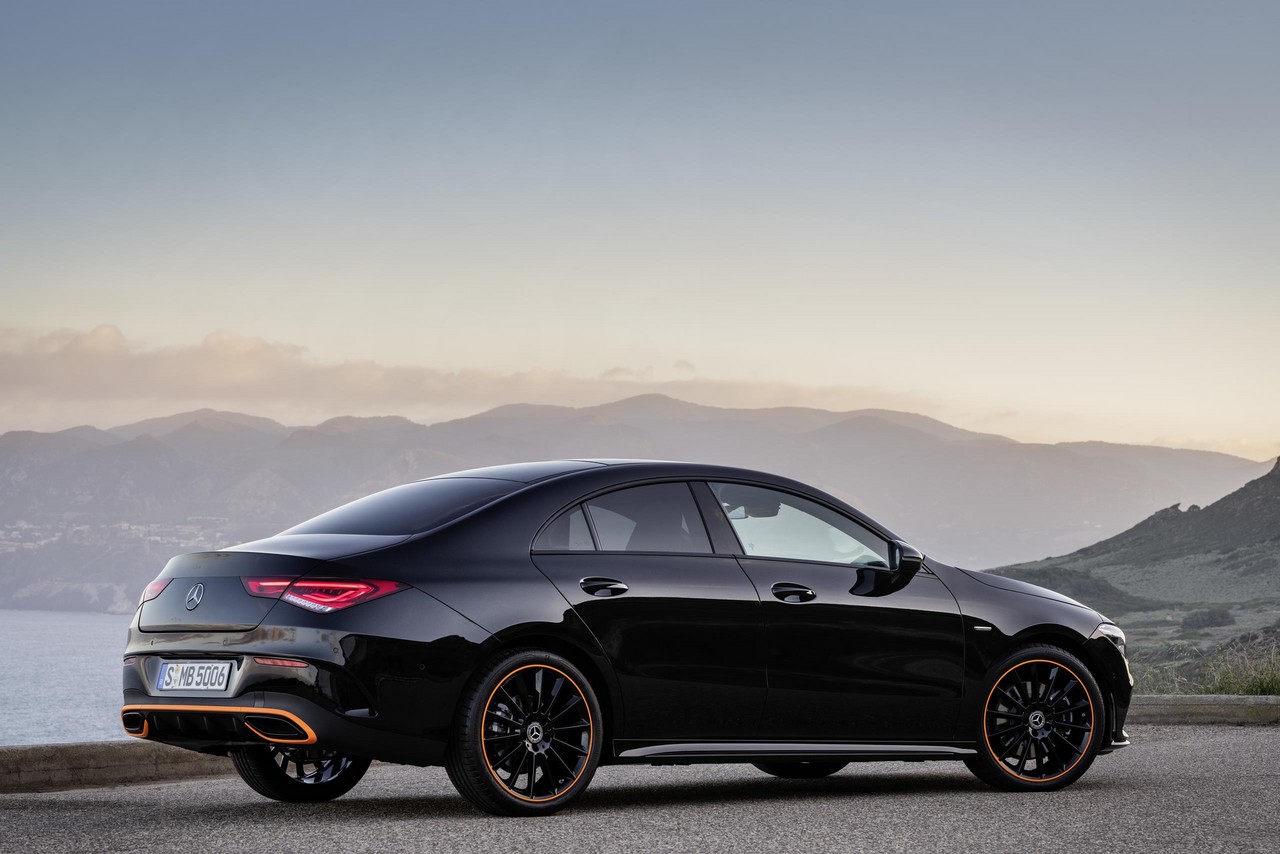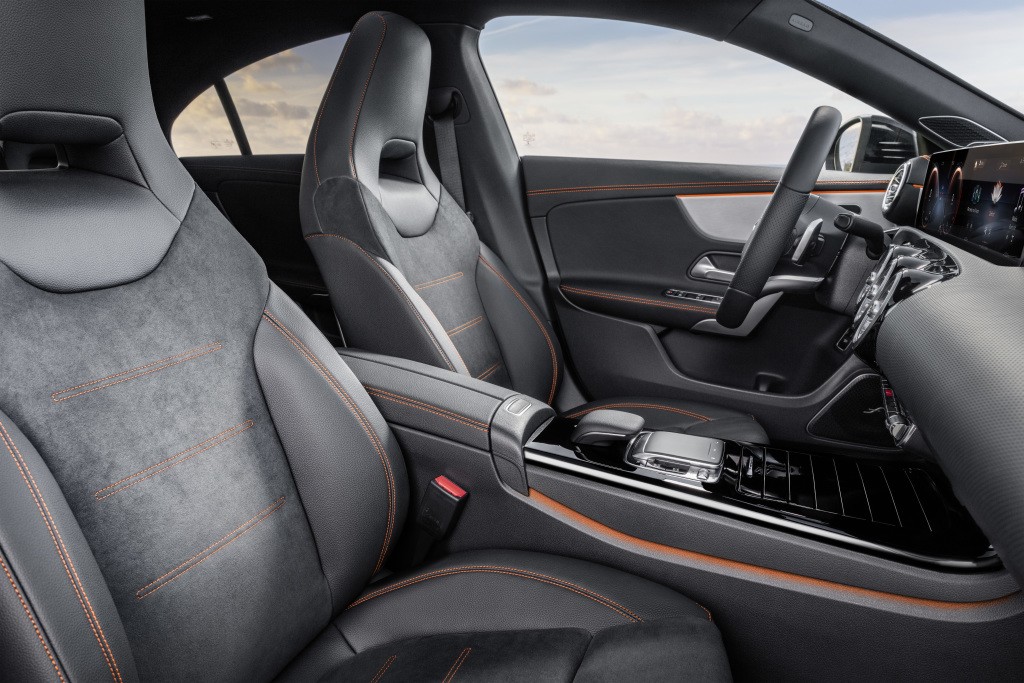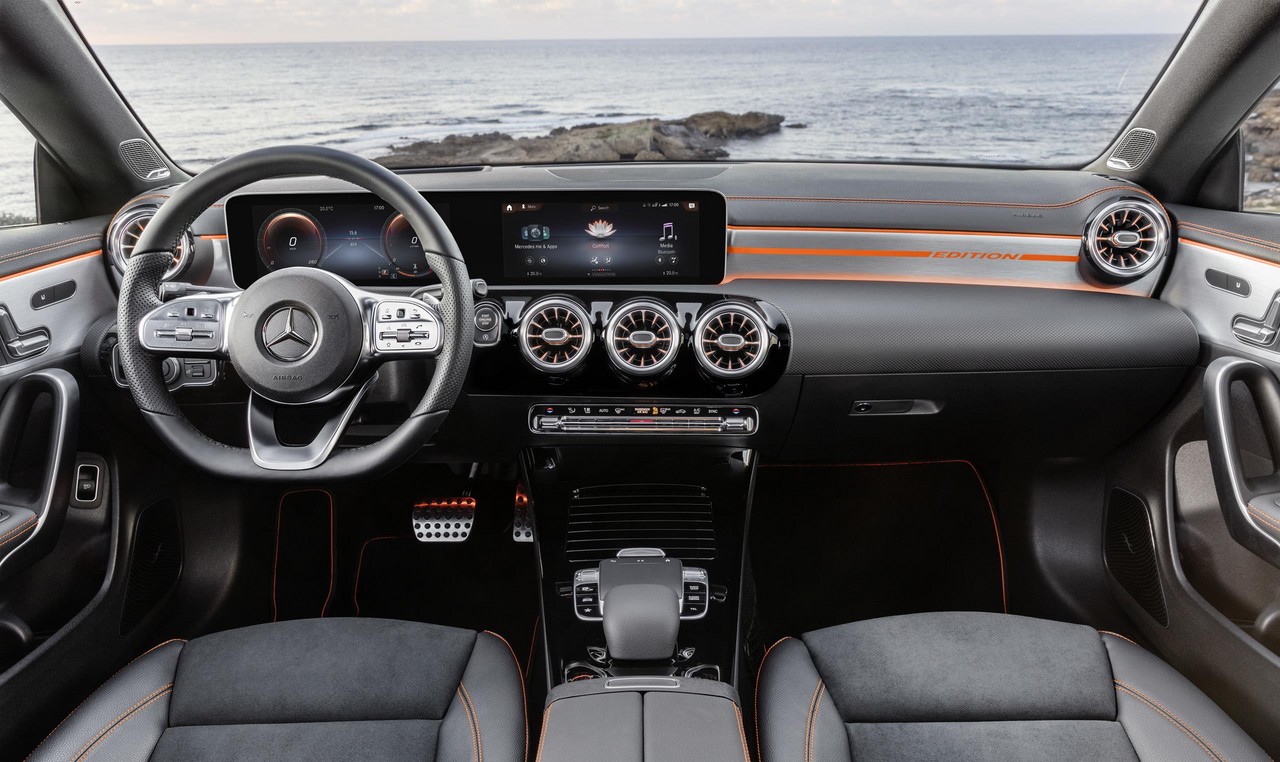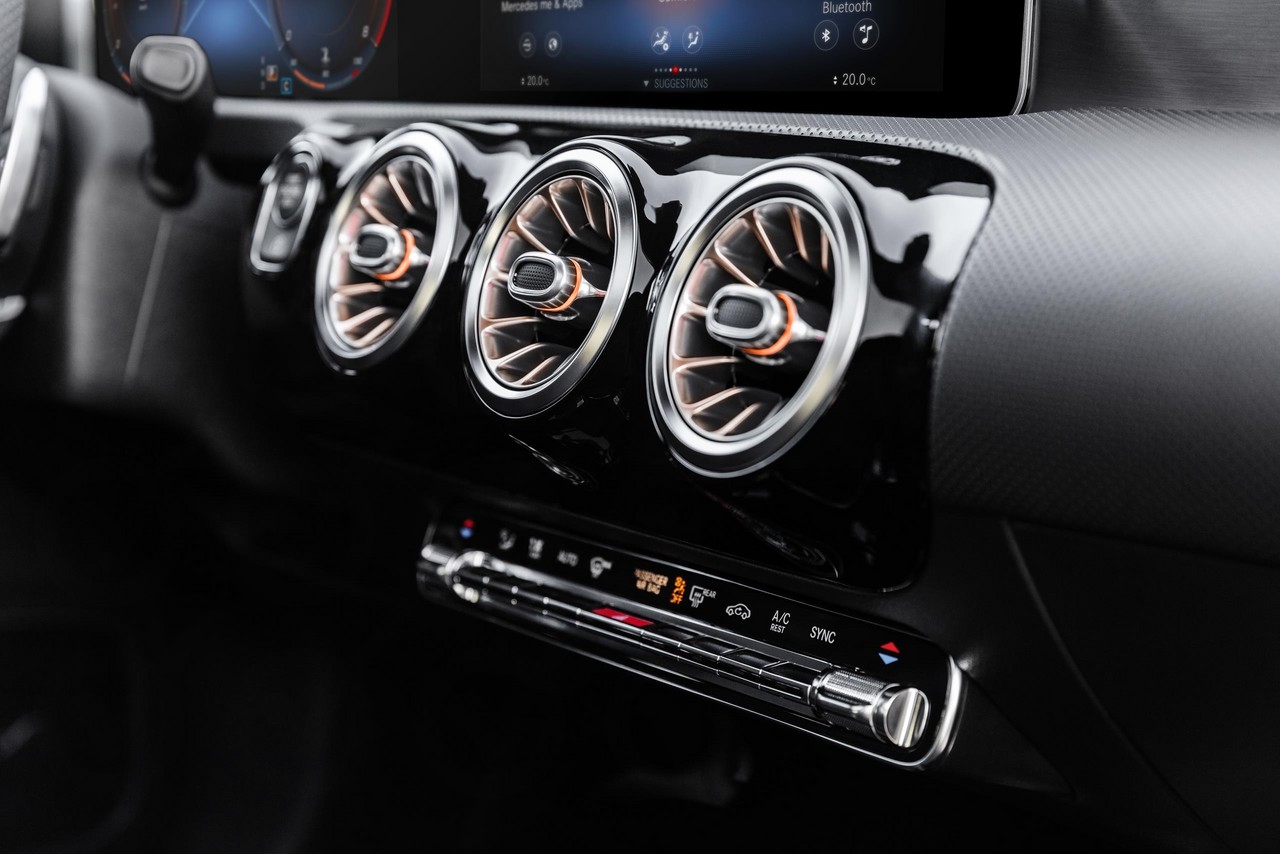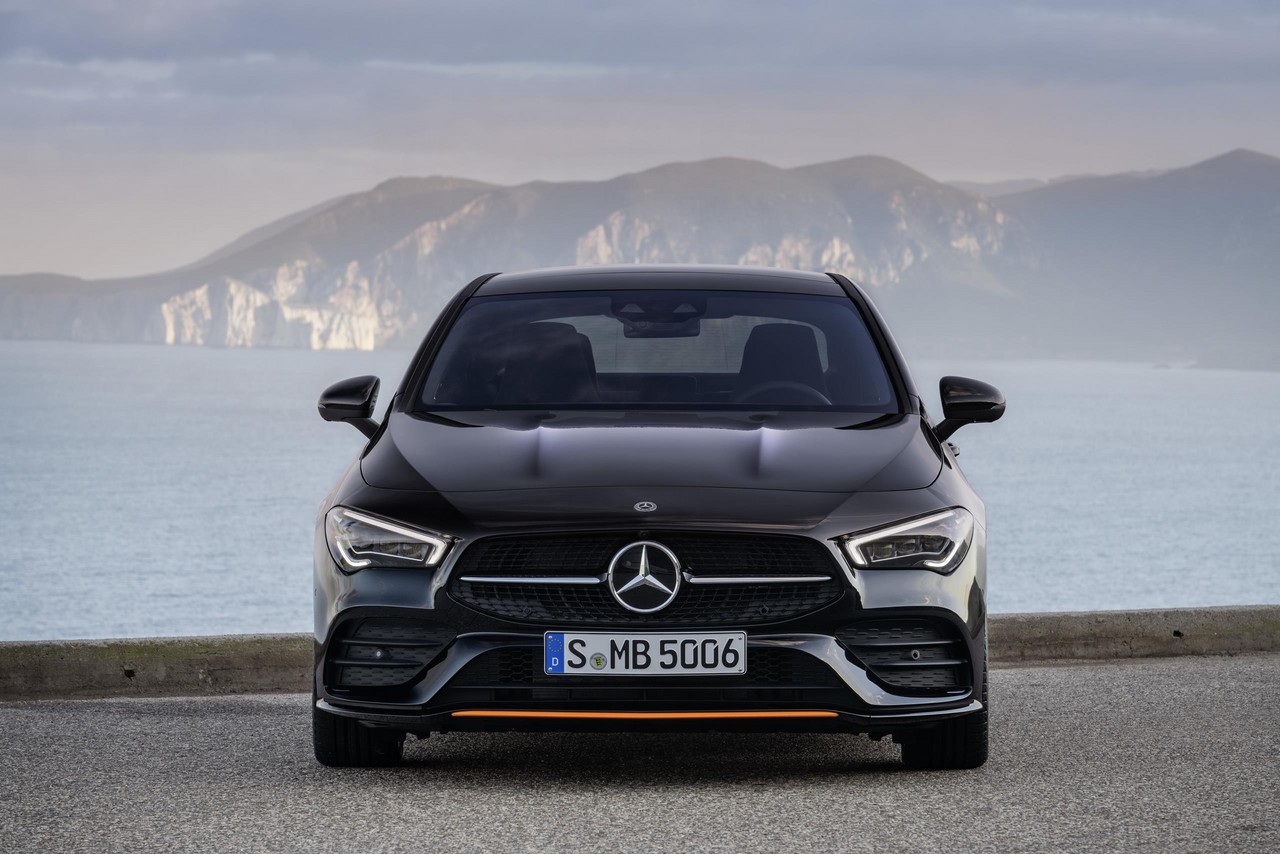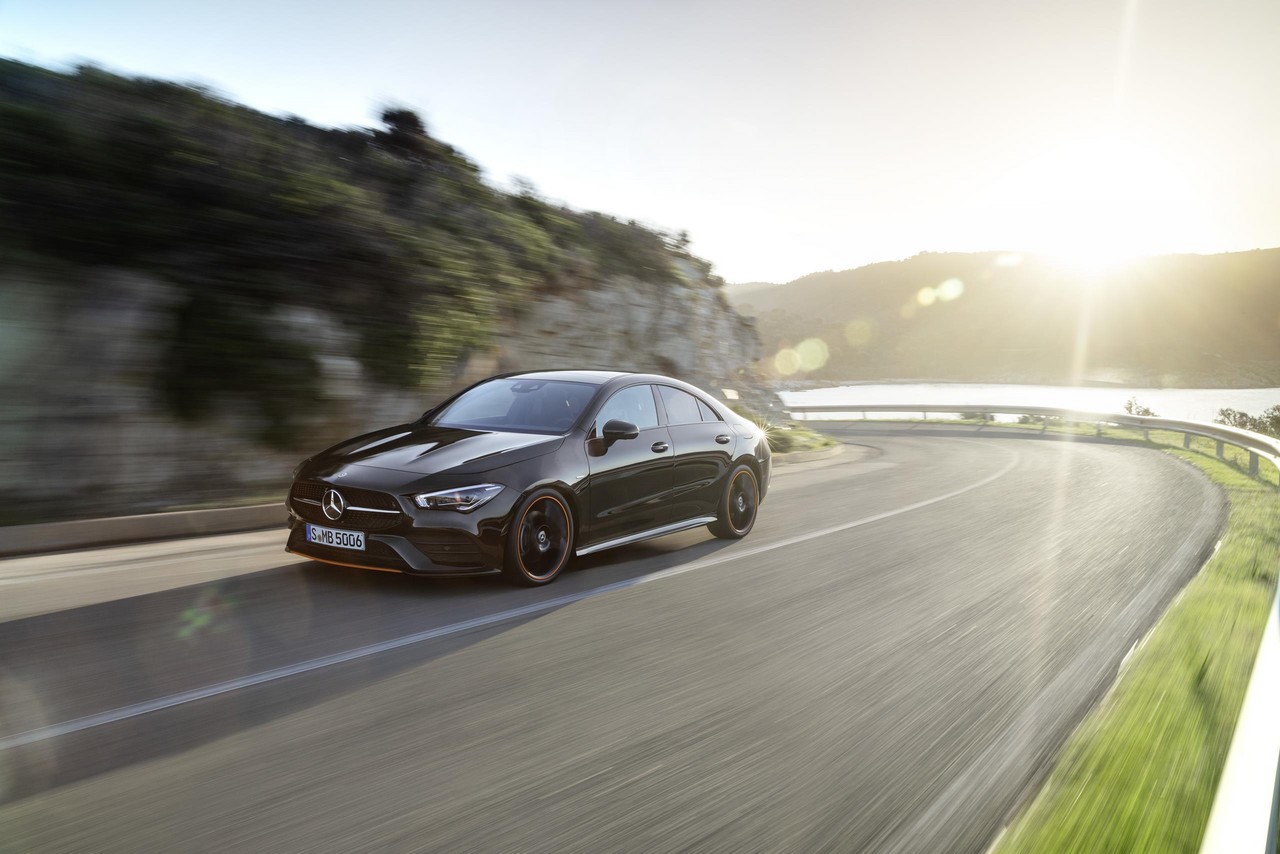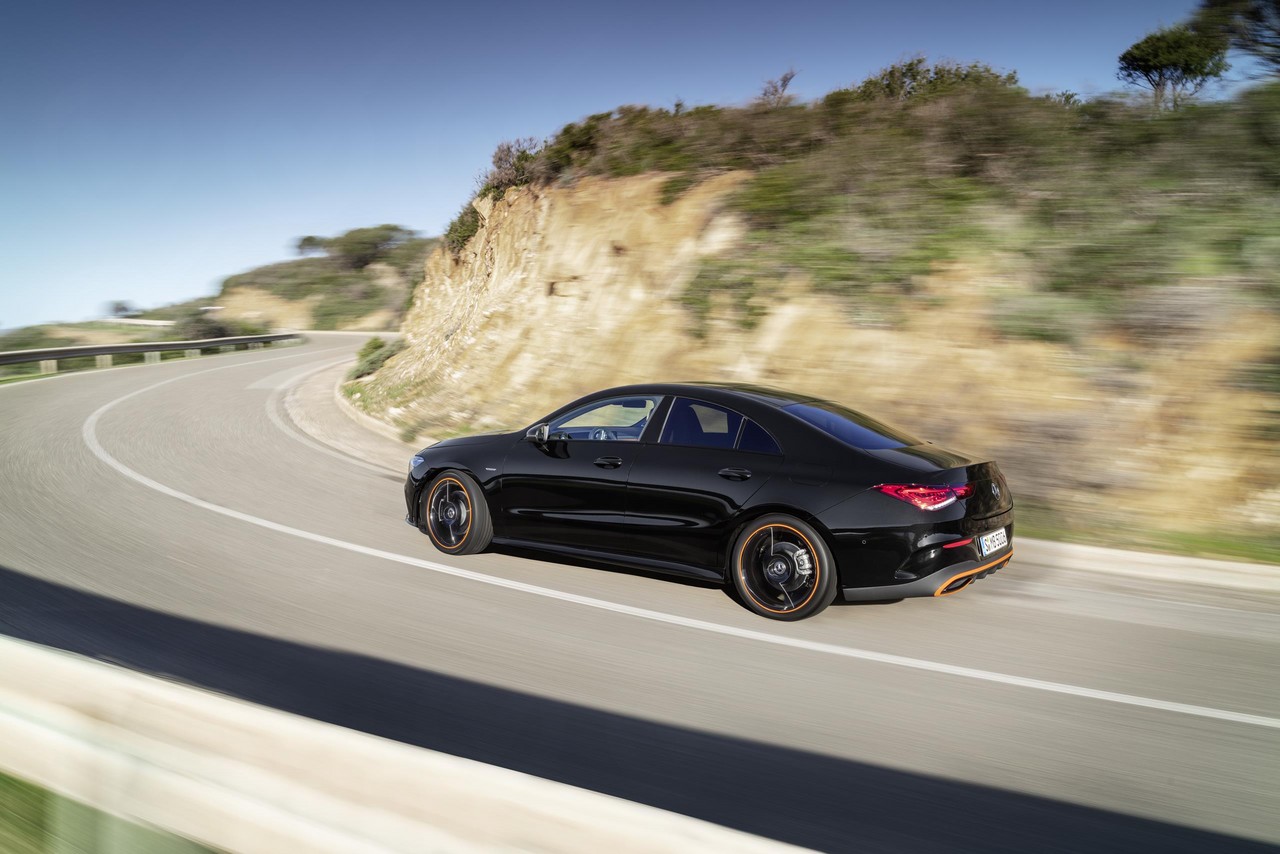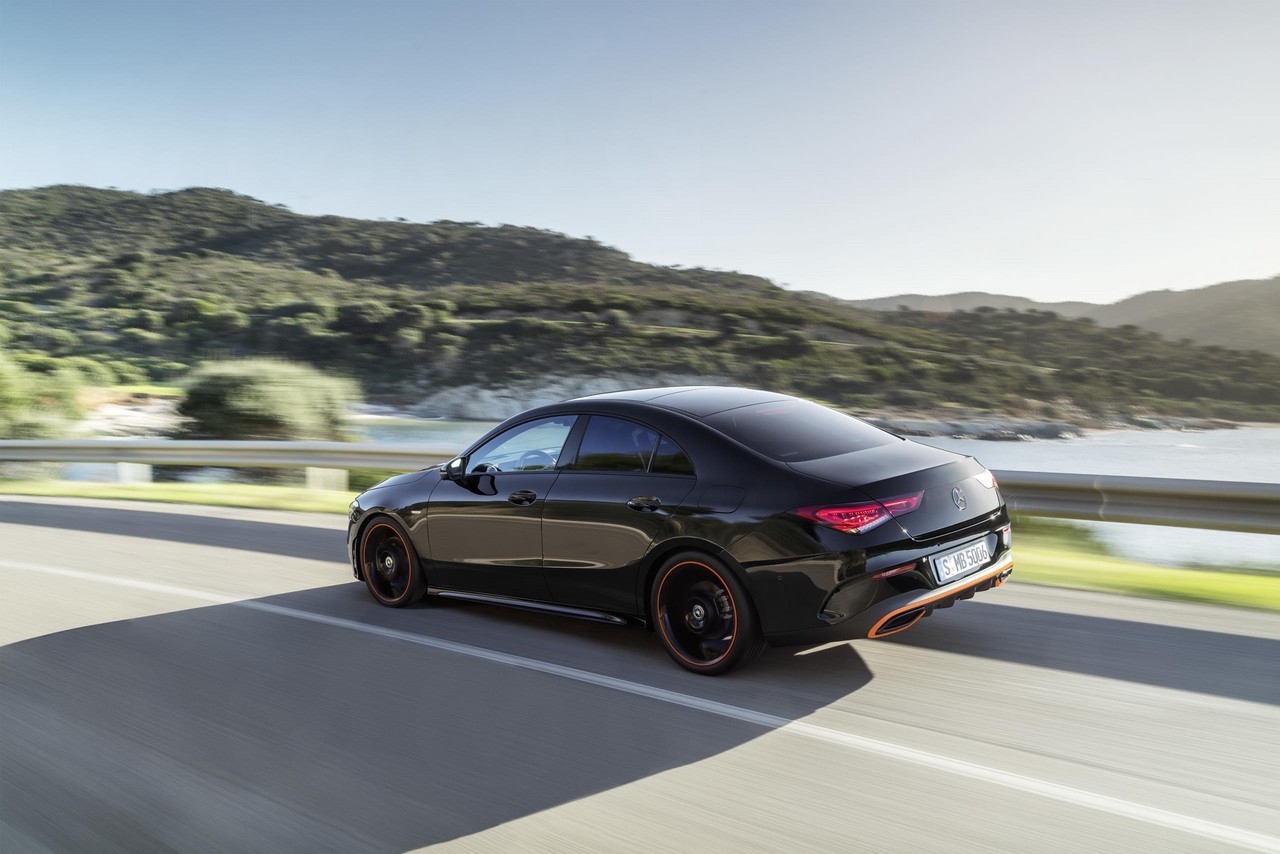
- New fuel-efficient M260 (for CLA 200) and M282 (for CLA 250 4MATIC) turbocharged petrol engines
- Accomplished ride/handling balance
- Reduced A-pillar cladding improves forward visibility
- High standard of interior fit and finish (though gloss black surfaces show fingerprint smudges)
- Good front seat space…
- … but poor rear seat head and leg room
- Dual clutch transmission (DCT) can produce initial acceleration surge when starting from rest
- For CLA 200, 1.3-litre turbocharged engine is underpowered and noisy above 3500 rpm. DCT also does multiple downshifts for moderate acceleration
- Tyre roar when driving on coarse chip bitumen
- Adaptive Cruise Control not standard and no conventional USB socket (USB-C only)
Overview
Released in Australia in July 2019, the Mercedes-Benz C118 CLA-Class was a compact sedan which had a coupe-like profile. Manufactured in Kecskemet, Hungary, the Mercedes-Benz C118 CLA-Class range for Australia initially consisted of the CLA 200, with the CLA 250 4MATIC following in October 2019.
| Engine | Trans. | Peak power | Peak torque | |
|---|---|---|---|---|
| CLA 200 | 1332 cc M282 turbo petrol I4 | 7sp DCT | 120 kW at 5500 rpm | 250 Nm at 1620-4000 rpm |
| CLA 250 4MATIC | 1991 cc M260 turbo petrol I4 | 7sp DCT | 165 kW at 5500 rpm | 350 Nm at 1800-4000 rpm |
4MATIC all-wheel drive system
The ‘4MATIC’ all-wheel drive system for the Mercedes-Benz C118 CLA 250 4MATIC included:
- A power take-off unit to the rear axle that was integrated into the dual clutch transmission; and,
- A multi-plate clutch that was integrated into the rear axle differential and electro-mechanically controlled (previously electro-hydraulically actuated).
In normal conditions, the engine’s torque was directed to the front wheels for maximum fuel efficiency. If, however, there was a loss of traction or such a loss was anticipated, then the electric motor would exert an axial force on the clutch pack – via a crown wheel and a ball ramp – to close the clutch plates so that 50 per cent of the engine’s torque was directed to the rear wheels (i.e. a 50:50 front:rear torque distribution). The advantages of this control system were:
- Non- rpm-dependent operation across the entire actuation range;
- Pilot control of the clutch while stationary; and,
- Higher efficiency due to the ball ramp concept.
Furthermore, the rear axle differential compensated for the different paths/rotational speeds of the rear wheels.
Body and dimensions
The C118 CLA Class was underpinned by Mercedes-Benz’s ‘Modular Front Architecture’ (MFA2) which was shared with the W177 A-Class . Compared to the C117 CLA Class , the Mercedes-Benz C118 CLA was 48 mm longer (at 4688 mm), 53 mm wider (1830 mm), 2 mm shorter (1439 mm) and had a 30 mm longer wheelbase (2729 mm). Boot capacity was 460 litres.
With its two-section ‘Airpanel’ louvre system behind the radiator grille, the Mercedes-Benz C118 CLA-Class had a drag co-efficient of 0.23 Cd. Other aerodynamic measures included:
- Sealed headlamp surrounds;
- New door mirrors;
- An aero lip in the bonnet’s joint to the front apron;
- Wheel arch spoilers, spoiler lips in the tail lights and on the rear bumper;
- Underbody panelling for the engine compartment, main floor, parts of the rear axle and rear diffuser;
- For models with petrol engines, a re-shaped rear exhaust silencer and heat shield; and,
- ‘Aerodynamically optimised’ wheels and tyres.
Suspension
The Mercedes-Benz C118 CLA-Class had MacPherson strut front suspension with a forged aluminium transverse control arm and tie-rod for each wheel. Furthermore, the MacPherson struts had transverse force-optimised coil springs and twin-tube gas-pressure shock absorbers with auxiliary springs.
The C118 CLA-Class was developed with two different rear suspension systems –
- The CLA 200 models had a torsion beam rear axle in which the U-section rotated in one-sided compression and rebound, and acted as a stabiliser bar. The torsion beam rear axle was secured to the body by two bearings; and,
- The CLA 250 4MATIC models had four-link rear suspension – consisting of three transverse arms and one trailing arm for each wheel – mounted on a sub-frame that was isolated from the bodyshell by rubber bushings.
Both rear suspensions had single-tube shock absorbers and separate coil springs. Furthermore, noise insulation of the coil spring between the body and rear axle was achieved with two elastomer insulators.
As an option, the Mercedes-Benz C118 CLA-Class was available with electronically controlled damping (‘active damping control’) whereby a valve in each of the four shock absorbers was electronically actuated to control oil flow and therefore damping characteristics. As such, damping was stiffened during acceleration, braking or steering manoeuvres to reduce pitch and body roll. In conjunction with ‘Dynamic Select’, the driver could also select from ‘comfortable’ or ‘sporty’ damper settings.
Steering
The Mercedes-Benz C118 CLA-Class had rack-and-pinion steering with speed-sensitive electric power assistance; the steering wheel required 2.6 turns from lock to lock. The electric servo unit could also assist driver steering movements that were intended to ‘stabilise’ the vehicle by generating additional steering torque – these included:
- Counter-steering in the event of oversteer;
- Steering corrections when braking on varying road surfaces;
- Reducing the steering effects of front-wheel drive; and,
- Compensation for crosswinds and road camber.
Safety equipment
Standard safety equipment for the Mercedes-Benz C118 CLA-Class included dual front airbags, a driver’s knee airbag, front seat thorax-pelvis side airbags, full-length curtain airbags, ABS, electronic brake force distribution, brake assist, electronic stability control, traction control and front seatbelts with pre-tensioners and load limiters.
The Mercedes-Benz C118 CLA-Class was equipped with camera and radar systems that can perceive up to 500 metres ahead of the vehicle. Fitted as standard, Active Brake Assist with cross-traffic function could mitigate the consequences of collisions with vehicles or pedestrians in front of the vehicle. If a collision risk was detected, the system initially issued a visual warning. If there was a serious risk of collision, the driver would receive an additional, audible warning and the required brake pressure to prevent a collision was calculated (if possible) so that it could be applied when the driver depressed the brake pedal. If the driver failed to respond, however, Active Brake Assist would initiate autonomous emergency braking to mitigate or prevent the collision.
For Australia, the Mercedes-Benz C118 CLA-Class was fitted with the following active safety technologies as standard:
- Active Lane Keeping Assist: operating at speeds from 60 km/h to 200 km/h, Active Lane Keeping Assist would warn the driver if the vehicle was unintentionally drifting out of its lane via pulsed vibrations through the steering wheel. If the vehicle crossed a continuous line, the system could direct the vehicle back into its lane by applying the brakes on one side of the vehicle. In the case of a broken line, such intervention occurred only when there was a collision risk with a vehicle in the adjacent lane (including oncoming traffic);
- Blind spot assist (passive): used two radar sensors in the rear of the vehicle to warn the driver if there was a vehicle in the driver’s blind spot when they applied the turn indicators prior to changing lanes;
- Exit Warning Assist: could issue a visual warning in the door mirror when the vehicle was stationary and up to three minutes after the ignition has been turned off to warn of an approaching vehicle or bicycle (providing it was exceeding 2 m/s). If the driver used the door handle during this time, an additional acoustic warning was issued;
- Crosswind Assist: could detect sudden, strong gusts of wind and prevent the vehicle from drifting out of its lane via corrective braking forces on one side of the vehicle;
- Pre-Safe Sound: emitted a brief rushing sound when a collision was imminent to trigger the stapedius muscle in the ear and reduce the risk of hearing damage;
- Attention Assist: monitored driver behaviour for signs of fatigue and, if detected, issued visual and audible warnings;
- Traffic Sign Assist: used navigation data and image recognition to display – in the instrument cluster – the maximum permitted speed, restrictions on overtaking and pedestrian warnings near ‘zebra’ crossings. Traffic Sign Assist also had an extended wrong-way warning, while the detection of stop signs was combined with the ECO start/stop function so that the engine kept running. Active Speed Limit Assist was a sub-function of Traffic Sign Assist that used the forward-facing camera to recognise sign gantries and road works signs to set the vehicle’s maximum speed; and,
- Pre-Safe Plus: used the rear radar sensors to detect if a rear-end collision was imminent and, if so, flashed the rear hazard lights and prepare occupant protection measures such as the seatbelt tensioners. If the vehicle was stationary and the risk of a collision persisted, the system could apply the vehicle’s brakes to reduce the risk of injuries by reducing the forward jolt caused by an impact from the rear.
As an extra-cost option, the Mercedes-Benz C118 CLA-Class could be specified with a ‘Driving Assistance Package’ which included the following –
- Active Distance Assist Distronic with Active Steering Assist: operating at speeds up to 210 km/h, this system could maintain a pre-set distance to the vehicle ahead. A stop-and-go function also enabled the vehicle to be braked until stationary, remain stationary for up to 30 seconds and then accelerate when the traffic ahead started moving. Active Distance Assist Distronic also combined navigation data with camera/radar inputs to adjust speed when approaching bends, junctions or roundabouts. Active Steering Assist helped the driver in keeping the vehicle in the centre of its lane by applying steering wheel torque, using lane markings for orientation at speeds up to 210 km/h and, at speeds up to 130 km/h, also used the position of vehicles ahead;
- Active Emergency Stop Assist: if it was detected that the driver was no longer actively driving the vehicle while it was moving, Active Emergency Stop Assist would bring vehicle to rest within its lane. If there was no steering wheel movement over a longer period when Active Steering Assist was active, the system would issue visual and audible prompts for the driver to place their hands on the steering wheel. If the driver did not respond, vehicle speed was reduced until stationary. At speeds below 60 km/h, following traffic was warned by the hazard warning lamps;
- Evasive Steering Assist: operating at speeds from 20-70 km/h, Evasive Steering Assist could assist the driver to avoid a pedestrian that was detected by the radar sensors and stereo camera. If the driver initiated an evasive manoeuvre by turning the steering wheel, the system provided ‘precisely calculated steering torque to support the movement of the steering wheel’ to avoid the pedestrian and then straighten the vehicle afterwards;
- The Cross-Traffic Assist: could operate at speeds up to 72 km/h and used the stereo camera and radar sensors to detect traffic that was crossing in front of or behind the vehicle. If detected, the driver would receive visual and audible alerts;
- Active Lane Change Assist: operating at speeds from 80 km/h to 180 km/h, Active Lane Change Assist could perform lane changes – within 10 seconds – in response to the driver nudging the indicator stalk; and,
- Active Blind Spot Assist: at speeds from 12 km/h to 200 km/h, Active Blind Spot Assist provided visual and audible alerts if there was a risk of a side collision when the turn indicator was actuated. As part of the Driving Assistance Package, the brakes on one side of the vehicle could be applied when travelling at speeds above 30 km/h to avoid a side collision.
The C118 CLA-Class had an ‘active bonnet’ which, in the event of a pedestrian collision, deployed pyrotechnic actuators to raise the height of the bonnet by around 80 mm to create additional clearance between the bonnet and components in the engine bay to reduce the risk of pedestrian injury.
Features: Mercedes-Benz C118 CLA 200
Inside, the Mercedes-Benz C118 CLA-Class featured the ‘Mercedes-Benz User Experience’ (MBUX) multimedia system which couldbe operated by touchscreen, buttons on the steering wheel, a touchpad on the centre console and voice control with natural language comprehension (‘Linguatronic’). For Australian-delivered vehicles, the C118 CLA-Class had two 10.25-inch displays: one for the instrument cluster and one for the media touchscreen.
The infotainment system for the Mercedes-Benz C118 CLA-Class included an HDD navigation system, a 225 watt ‘Advanced Sound System’ which had nine speakers and a subwoofer, a digital radio tuner (DAB+), Bluetooth mobile phone connectivity, a smartphone integration (Apple CarPlay and Google Android Auto) USB-C connection and wireless mobile phone charging.
Beyond this, standard features for the Mercedes-Benz C118 CLA 200 included dual-zone climate control air conditioning (‘Thermotronic’), cruise control, LED headlights with integrated LED daytime running lights, dusk-sensing headlights, rain-sensing wipers, front and rear parking sensors, a reversing camera with dynamic guidelines, a rear fog lamp, 40:20:40 split and folding rear seats with a through loading feature, leather steering wheel with gearshift paddles, remote central locking with proximity key (i.e. keyless entry), power adjustable mirrors with heating and folding functions, power windows, an automatically dimming rear-view mirror, push-button start, an electric park brake, ambient interior lighting, illuminated vanity mirrors, a 12 volt power socket (in the luggage compartment), black roof lining, tyre pressure monitoring, a trip computer and an immobiliser.
The Mercedes-Benz CLA 200 was also equipped with –
- Active Parking Assist: could identify suitable parallel parking spaces – when traveling at speeds of up to 35 km/h – and steer the vehicle into the parking space while the driver controlled vehicle speed; and,
- Adaptive Highbeam Assist: could automatically dip or mask the headlights to avoid dazzling other drivers.
Features: Mercedes-Benz C118 CLA 250 4MATIC
Compared to the C118 CLA 200, the Mercedes-Benz C118 CLA 250 4MATIC was further equipped with ‘Mercedes me Connect’ which enabled smartphone-controlled functions such as Remote Engine Start and a power-operated panoramic glass sunroof. Visually, the CLA 250 4MATIC could be identified by its ‘Night Package’ which consisted of tinted privacy glass and gloss-black exterior trim enhancements.
Brochure and specifications
- Brochure: Mercedes-Benz C118 CLA-Class (May 2019)
- Specifications: Mercedes-Benz C118 CLA-Class (July 2019)
